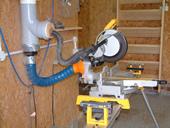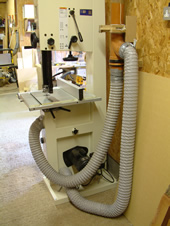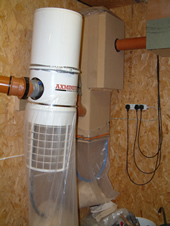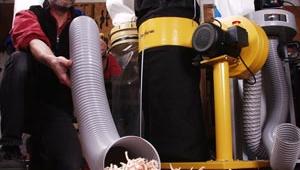Understanding dust extractors

Efficient extraction
In the home workshop, even with the most efficient dust extraction system, it is not practical to extract 100% of the dust produced. Many tool manufacturers, even the better ones, treat dust extraction as an afterthought. It is true though that some tools are very difficult to extract from, for instance mitre saws. I have a new mitre saw which fires dust everywhere. The space under the saw usually had several inches of accumulated dust, however I have now fitted a flexible dust port for use in the workshop. This has largely cured the problem, but it would be better if manufacturers put more thought into extraction at the design stage.One good test of the overall efficiency of the dust extraction system is to allow the sun to cast a beam of light across the workshop and see just how much particulate is suspended after machining. It can also be enlightening to shine a beam of light near the dust extractor when it is running, as it will give you a good idea of just how much dust is getting through the filters. My extractors were in the corner of the room and the walls around them were covered in a layer of very fine dust, which I didn't find very reassuring.
This article is aimed at the home user, as there are more stringent regulations concerning professional workshops and commercial premises. More information can be found from the Heath and Safety Executive; www.hse.gov.uk/pubns/woodindx.htm

Dust and chip
There is some confusion with regard to wood dust. When does wood chip become wood dust? Officially I think it is when the dust is less than 25microns in size but, in my opinion, if you can breathe it in it is dust if you can't it is chip. One common misconception is that sanding produces dust and all other machining operations produce chips. In reality fine dust is produced from most machining operations; even a thicknesser will produce plenty of fine dust together with vast quantities of chips.Dangerous dust
As a general rule hardwoods are more hazardous to human health than softwoods. This is probably because they contain tannin or similar compounds, and because they generate finer particles when machined. However there are exceptions, for instance Western Red Cedar, which is a softwood and yet particularly hazardous.Dust from man-made boards, principally MDF, is thought by many to be very dangerous, but the main danger here is that the dust is very fine rather than particularly toxic.
Most dust we breathe in is filtered out by hairs and mucus in the nasal passages, but very fine dust is able to get past our defences and into our lungs.
Wood dust can cause asthma, dermatitis and rhinitis. Also there is some evidence that it can cause nasal cancer, although this is rare.
All wood dust should be considered potentially hazardous but this is a short and incomplete list of woods for which one should take extra care: Ebony; Greenheart; Iroko; Maple; Oak; Obeche; Oleander; Olivewood; Rosewoods; Satinwood; Spalted Beech; Western Red Cedar; Teak; Yew
If you need to machine tanalised timber, apart from the airborne dust being particularly hazardous; the resulting waste should be disposed of carefully and not burnt, as the resulting ash will contain arsenic. More information can be found from the Health and Safety Executive at http://www.hse.gov.uk/pubns/wis30.pdf
Performance is often quoted in different units, air flow for instance m3/hr, ft3/minute, litres/sec, and motor power is quoted in horse power and watts. This makes it difficult to compare models.
Conversion chart1 litre = 0.035ft
1ft = 28.3 litres
1litre/sec = 2.12 ft/min
1 litre/sec = 3.6m/hr
1m/hr = 0.28litres/sec
Fires and the risk of explosion
As wood dust travels along plastic ducting, it builds up a static charge, and as wood dust is potentially explose a mixive, we havture of spark and explosive which is not a good mix; so it is wise to install a means of discharging any static electricity generated.To keep things in perspective according to the HSE there were on average less than five explosions or fires each year associated with the collection of wood waste between 1990 and 2000 but no one wants to be one of those five, so it is worth taking some precautions.
When wood dust burns in suspension it produces a flash fire, if the wood dust is contained within an enclosure the pressure build up can produce a destructive explosion. This can then disturb dust deposits within the workshop and create a dust cloud, which if ignited by burning particles from the first explosion can result in a secondary explosion more destructive than the first. Therefore keep your workshop as clean as possible; it only takes about 100 grams of dust per cubic metre to form an explosive mixture.
It is worth designing some explosion relief into any ducted system. If a bag collector is fitted then an explosion would hopefully push the bag off and with a push-fit system the duct could simply push apart. With drum collectors the transport ring should be discarded in use so that it too can pop apart should an explosion occur. On a larger system a lightweight panel which will easily pop open, without itself becoming a dangerous missile, is the best option. Another source of explosions in workshops has been electrical equipment; regulations on electrical equipment for workshops changed in 2003 and new equipment has to meet new standards for explosion protection.
Naked flame is the most obvious cause of workshop fires, but also faulty electric wiring and appliances can be a source of ignition, don't let wood dust accumulate especially inside your machinery.

Precautions
Efficient extraction at source is the most effective method of reducing the hazard of wood dust, but with many machining operations it is still wise to wear a respirator.I have also two workshop air filters, and it is surprising how quickly these filters become dirty (Pic 2), but this type of air cleaner is only useful as an addition to and not an alternative to extraction. One problem with filters of this type is noise. I have a small Microclean unit in my smaller workroom, but it is so noisy and annoying that I rarely use it. The larger Axminster MTM Air filter in my main workshop is much quieter and I have that running all the time I am in the workshop. Another consideration with these machines is that they move a lot of air around the room, and it can be quite chilling if you stand in the air stream for any time.
- Log in or register to post comments






